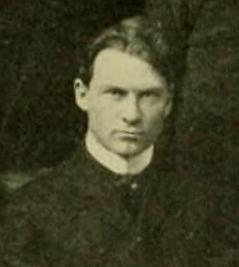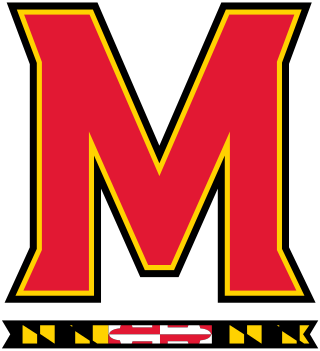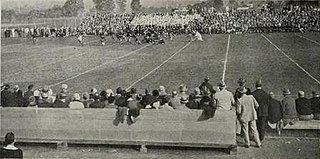
Harry Clifton "Curley" Byrd was an American university administrator, educator, athlete, coach, and politician. Byrd began a long association with the University of Maryland as an undergraduate in 1905, and eventually rose to the position of university president from 1936 to 1954.

Thomas Allison Mont was an American educator, university administrator, college football coach, and National Football League (NFL) player. He played quarterback for the Washington Redskins as a back-up behind Sammy Baugh for three seasons. Mont served as the head football coach for three years at the University of Maryland and eighteen years at DePauw University. He also served as the DePauw athletic director for fifteen years.

Fred Kenelm Nielsen was a Danish-American lawyer, diplomatic official, and college football coach. Nielsen served as the head football coach at the Maryland Agricultural College—now known as the University of Maryland, College Park—from 1905 to 1906, the George Washington University from 1907 to 1908, Georgetown University from 1910 to 1911, and the Catholic University of America from 1915 to 1916.

Samuel Stephen Cooke Sr. was an American college football coach. He served as the head football coach at Maryland Agricultural College—now known as the University of Maryland, College Park—in 1899, compiling a record of 1–4.

Grenville Lewis Jr. was an American college football player and coach, an early professional football player, and an engineer and cattle rancher. He served as the head football coach at Maryland Agricultural College—now known as the University of Maryland, College Park—in 1896, compiling a record of 6–2–2.

The Maryland Terrapins, commonly referred to as the Terps, consist of 19 men's and women's varsity intercollegiate athletic teams that represent the University of Maryland, College Park in National Collegiate Athletic Association (NCAA) Division I competition. Maryland was a founding member of the Southern Conference in 1921, a founding member of the Atlantic Coast Conference in 1952, and a member of the Big Ten Conference since 2014.

The Maryland Terrapins football team represents the University of Maryland, College Park in the sport of American football. The Terrapins compete in the NCAA Division I Football Bowl Subdivision (FBS) and the Big Ten Conference. The Terrapins joined the Big Ten Conference on July 1, 2014, following 62 years in the Atlantic Coast Conference as a founding member. Mike Locksley is the head coach of the Terrapins.

The modern Maryland Terrapins football program representing the University of Maryland traces its lineage to the team first formed at what was then the Maryland Agricultural College (MAC) in 1892. In the initial years, due to the rudimentary state of intercollegiate athletics and interstate travel, all games were played against local colleges, high schools, and athletic clubs.
Gerald Theodore "Snitz" Snyder was an American football player and Army officer. He played college football as a back for the Maryland Terrapins at the University of Maryland. Snyder played professionally for two seasons in the National Football League (NFL).
From 1947 to 1955, Jim Tatum served as the head coach of the Maryland Terrapins football team, which represented the University of Maryland in National Collegiate Athletic Association (NCAA) college football. Maryland hired Tatum to replace Clark Shaughnessy after the 1946 season. Tatum had created both success and controversy during his one season as head coach of the Oklahoma Sooners football team. During his nine-year tenure, Tatum became one of the most successful head football coaches in Maryland history, and the Terrapins compiled two national championships, three conference championships, and five bowl game appearances. His teams compiled a 73–15–4 record without a single losing season, and as of the end of 2016, he has the highest winning percentage of any Maryland football coach who coached at least seven games. In 1954, the University of Maryland appointed a new president, Dr. Wilson Elkins, who chose to de-emphasize football. Following the 1955 season, Tatum took a pay cut to coach at his alma mater, North Carolina, and he died four years later.
The Maryland Intercollegiate Football Association (MIFA), also called the Maryland Intercollegiate League, was an early college football conference with a membership composed of schools located primarily in the state of Maryland. One exception was Gallaudet, which is located in Washington, D.C. All of the members were universities, except Baltimore City College, a preparatory school located in Baltimore, Maryland.

Old Byrd Stadium, also known as Byrd Stadium or Byrd Field and nicknamed "the Byrd Cage", was the home stadium for the University of Maryland from 1923 until 1947. It was located in College Park, Maryland, east of Baltimore Avenue on the site of the school's present-day fraternity row. The seating capacity for the stadium was 5,000.

The 1892 Maryland Aggies football team represented the Maryland Agricultural College in the 1892 college football season. It was the first football team to officially represent the school. Maryland played three games, all of which it lost, and failed to score any points. Halfback Pearse "Shorty" Prough gained the only positive yardage for the team against Episcopal High School. He netted 35 yards from scrimmage after first running 30 yards in the wrong direction. It remained the only winless Maryland team until matched by the 1967 squad coached by Bob Ward.
The 1893 Maryland Aggies football team represented the Maryland Agricultural College in the 1893 college football season. After losing all three of its games the previous season without scoring a point, Maryland showed considerable improvement in 1893. The Aggies defeated all six opponents and were named the District of Columbia and Maryland state champions.

George V. "Shorty" Chalmers was an American college athlete. He served as the quarterback of the University of Maryland football team from 1929 to 1931. Chalmers also played basketball and baseball at Maryland. He has been inducted into the Delaware Sports Hall of Fame and the University of Maryland Athletic Hall of Fame.

William W. "Moon" Evans was an American attorney, Marine Corps officer, and athlete. He played college football, basketball, and lacrosse at the University of Maryland. In lacrosse, Evans led the nation in scoring in 1929 and 1930. He was inducted into the National Lacrosse Hall of Fame in 1966 and the University of Maryland Athletic Hall of Fame in 1983.
The 1932 Maryland Terrapins football team was an American football team that represented the University of Maryland in the Southern Conference (SoCon) during the 1932 college football season. In their 22nd season under head coach Curley Byrd, the Terrapins compiled a 5–6 record, finished 16th place in the SoCon, and were outscored by a total of 158 to 148.
The 1905 Maryland Aggies football team represented Maryland Agricultural College in the 1905 college football season. In their first season under head coach Fred K. Nielsen, the Aggies compiled a 6–4 record and were outscored by all opponents, 131 to 66. Coach Nielsen had a full-time job with the State Department while coaching football. Curley Byrd, who went on to be Maryland's head coach from 1911 to 1934 and its university president from 1936 to 1954, played on the 1905 team.
The 1923 Maryland Aggies football team was an American football team that represented the University of Maryland in the Southern Conference during the 1923 college football season. In their 13th season under head coach Curley Byrd, the Aggies compiled a 7–2–1 record, finished seventh in the conference, and outscored opponents by a total of 214 to 56. The team shutout five of its opponents and held Johns Hopkins and Catholic to just six points apiece.













